Artwork #2 (Appropriation): The Game of Real Life
Overview/Rules:
For this project, I appropriated The Game of Life. Using all of the game’s preexisting pieces and its board and modifying them as little as possible, I created a game that more accurately reflects the experience of going to college, beginning a career, and trying to maintain a healthy balance of happiness and income while making an effort to keep anxiety levels as low as possible. The game is based on the life of a game designer, as I wanted to make the game semi-autobiographical and something that I personally found relatable. The game uses actual pocket change as currency as opposed to fake in-game money in order to reflect the stress of a tight-budget and to make the experience feel more realistic. Players keep their coins in pill bottles to further enforce this stress. Instead of using cars as player pieces, I used the small pegs that go in the cars as the player pieces and painted them to be the primary colors as a social criticism on the concept of gender.

The board and all of the game’s components
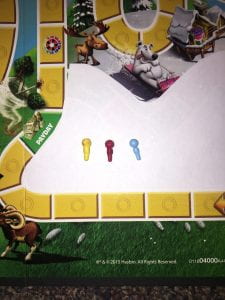
Player pieces
I also appropriated some of the basic rules of the game Careers. In Careers, players create their own win conditions by deciding how much happiness, money, and fame (out of a total of 60) they need to win. Players can distribute these 60 points however they choose. In my game, players split 40 points between happiness and money ($1 = 10 points, 1 happiness = 1 point) but must also keep their anxiety level below 5 points in order to win the game. Winning the game is very possible, but it is definitely not easy.
The anxiety stat works to reflect actual anxiety in a number of ways. Firstly, players must pay 1¢/anxiety point per paycheck to pay for therapy and anti-anxiety medication. Players can choose at any point to skip a turn (meant to represent taking a day off of work and stepping away from stressful responsibilities) and take an anxiety card instead, which relieves anxiety and will lower the player’s anxiety level. This is meant to encourage the concept of taking care of yourself.
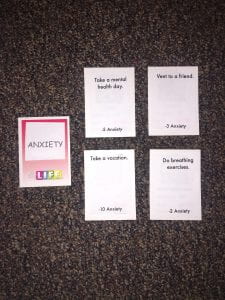
Examples of anxiety cards
At the start of the game, players first make their win conditions and then decide to either go to college or begin a career.
Players who go to college receive 10¢ at the start, must pay back their college loans ($3, an absurdly large sum that is difficult to obtain throughout the course of the game) before the end of the game, and choose from a college-specific set of action cards during their time in school that generally create opportunities for greater success for the player later on in the game, though the payoff is not immediate (meant to represent the importance of going college in getting a career).
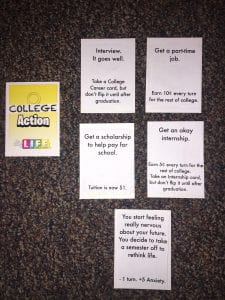
Examples of college-specific action cards
Players who choose to start a career start with 20¢, must pay rent of 1¢/paycheck, and, on the whole, make less money than college grads throughout the game, but they do not need to pay the absurd cost of college, which is this path’s main appeal.
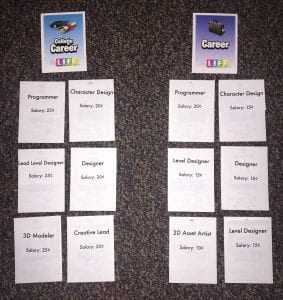
College graduate career salaries vs. non-graduate career salaries
Each turn, players spin the dial to move and will take an action card that affects either happiness, money, or anxiety. There are many positive action cards that increase the player’s happiness and income (through promotions, bonuses, and well-selling games), but there are also many negative action cards that cause the player stress, cut salaries, cause players to lose their job or make hard decisions (such as quitting their job and losing their source of income or taking on a huge amount of anxiety due to an abusive boss or an absurd workload), or lose money on increased rent, purchasing a car, etc. I modified to board so that there are no spaces besides action spaces.
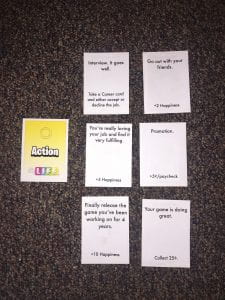
Examples of positive action cards

Examples of negative action cards
I wanted player choice to be very important to the game. Players can choose to take care of their mental health or “overwork” themselves to make more money than their competitors or try to be happier than their competitors. Even though competition is highly irrelevant to winning the game, there is still a sense of competition when playing with others, which is meant to represent how we as human beings are constantly comparing ourselves to the people around us even though they have no bearing on our lives or on our success.
First Iteration:
For the first iteration of this game, I did not have the board or any of the pieces yet. I only had a paper prototype and no action cards, so everything was written on the board. Also, it was only after the first playtest of the game that I decided that the game should include separate anxiety cards that the player must consciously decide to take instead of simply having action cards that lowered anxiety mixed in with the rest of the action cards, which took no thought and was simply a matter of luck. This was one of the biggest changes I made between the paper prototype and the final version. Other than this, I did not make any major changes to the structure of the game. I did, however, make some smaller changes, such as deciding to use actual change and use its actual value as opposed to using an abstracted form of currency or using real change but changing its value. I also decided to make it harder for those who choose to start a career earlier on to make as much money as those who choose to go to college, because in the first iteration, players had a 50/50 chance to “get lucky,” which I simply don’t think is realistic.
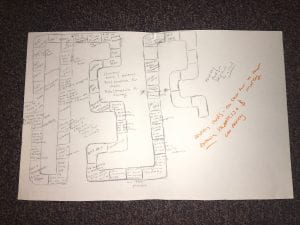
Paper prototype
Inspiration:
I was highly inspired by Peter Thibeault’s appropriation exhibit at Gallery 360. After learning about his work and the way he employs game pieces to have a specific artistic meaning, I decided I definitely wanted to use a preexisting game and all of its pieces as the basis of my appropriated game. I decided I wanted each piece to have a very specific and thoughtful meaning in the context of the rules of the game and the statement it makes, which I think I accomplished.
I was also inspired by Yoko Ono’s White Chess, which I think makes a very powerful statement by making very small but thoughtful changes to a preexisting game and keeping all of the mechanics the same. This was my main goal in mind when creating my game— I wanted to make small changes that did not drastically change the game and its mechanics but entirely changed the game’s meaning.
